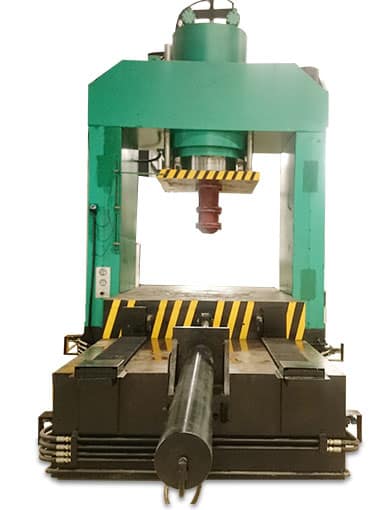How to Use a Hydraulic Press Brake
time:2023-05-22 views:(点击 815 次)
Hydraulic press brakes are an invaluable asset in any metal fabrication shop, yet many experienced metal workers fail to properly comprehend how this machine operates.
To maximize their use of a press brake, users should understand its fundamentals as well as how to read drawings and understand basic capacity charts.
Getting Started
At first, it is important to familiarize yourself with the capabilities of your press brake. A press brake capacity chart may be available online that provides options such as steel thickness and v-die opening size - these charts will assist in calculating an appropriate tonnage for your job so as not to use too little or too much force and damage the machine.
Next, it is necessary to decide on an acceptable bending method and tooling. Engineering professionals can learn much by visiting the shop floor and speaking to press brake operators about what they should expect from the machine. They could even collect information on punches and dies so they can design parts around what the press brake can accomplish.
Press brakes are constructed using a C-shaped frame with left and right upright plates attached to a worktable (or bed), as well as an uprightly moving vertical ram constructed of whole steel plate that connects to hydraulic piston rods for power supply on either side of hydraulic oil cylinders on each axis.
Setting the Tooling
Prior to using a press brake, its tooling must first be assembled. This step can be time-consuming and costly if improper setup procedures are utilized; good setup procedures can make a big difference here.
By using tools with identical height specifications, it can reduce the time taken to set them up between jobs - saving precious billable hours that would have otherwise been spent waiting on a technician to arrive and fix your machine before getting it running again.
Hydraulic press brakes are C-shaped structures with vertical plates on either side, a worktable (bed), and connecting supports, each fitted with hydraulic cylinders on both sides to control its ram part used to bend metal. Springback monitoring tools may also be included as springback is the tendency for bent material to return back to its original straight shape after being bent by punch.
Loading the Material
No one can produce the ideal press brake bend, but an experienced fabricator can come close. To achieve success, avoid short cuts and follow a series of steps carefully that involve checking, adjusting, and rechecking both the machine, its tooling, and material being bent.
Understanding the required bending force is also crucial when undertaking any job, with higher tonnages being optimal for thicker metals while lower ones work best with thinner materials. If unsure, mechanical crowning systems can assist by automatically determining how much tonnage should be added or retrofitted onto existing machines.
Hydraulic press brakes come in manual or automated varieties and come in sizes that range from 50 tons to 300 tons. Electric models have become popular as an efficient way of cutting maintenance costs while helping the environment by using less hydraulic oil for their operation. Even so, regular inspections and weekly cleaning should still be included as part of a good press brake maintenance regimen.
Keeping the Machine Clean
Press brake operators must regularly clean touch screen controls, back gauges and other surfaces used during their shift to avoid operational errors resulting from hand oil and grease build-up on them; this may affect safety lasers that must be free from dust or debris in order to operate effectively.
An important practice when operating a press brake is cleaning its ram rod surface regularly in order to remove dirt or debris that might damage seals, potentially leading to oil leakage. Furthermore, its electrical cabinet should also be thoroughly inspected regularly in order to ensure airflow remains unobstructed and that its emergency stop button works efficiently.
Finally, an operator should double-check that their machine is level and secured before tightening all bolts on it. A service technician should also be brought in annually for more thorough examination of mechanical and hydraulic circuits not easily accessible by operators.
Link to this article: https://www.ihydraulicpress.com/mk/3083.html
Hot Articles
-
How Dangerous Is a 50 Ton Hydraulic Press?
Hydraulic presses are highly versatile machines that can perform a range of functions – from crushing large objects to shaping metals –……
-
Can You Crush a Diamond With a Hydraulic Press?
Diamonds may be one of the hardest materials on Earth, yet they can still be broken by even standard hammers if hit hard enough. The Hydraulic Pre……
-
How to Hydraulic Presses Converter Rosin
Rosin has traditionally been produced at home using hair straighteners; however, using a hydraulic or pneumatic press can generate far higher yiel……
-
Hydraulic Press for Machinery Repair
Hydraulic presses are indispensable tools in the machine shop, but like any piece of machinery they require regular upkeep and care to remain at the……
-
How to Calculate Tonnage of a 400 Bar Hydraulic Press
Hydraulic presses are powerful pieces of machinery designed to exert tremendous forces. Used to bend or shape metal, as well as for manufacturing ……
-
How Much Force Is Applied to a Hydraulic Press?
Hydraulic presses use a straightforward process to generate force. Pressure generated within an enclosed fluid space multiplies with the ratio bet……
-
Hydraulic Press For Plastic Molding
Hydraulic presses utilize the pressure of a contained fluid to shape and deform materials such as metals, plastics, rubber and wood. Hydraulic formi……
-
Hydraulic Press for Stamping
Hydraulic presses are commonly employed in metal-forming operations such as blanking, forming, bending and flanging. With their low initial cost and……
Latest News
-
How to Build a 100 Ton Hydraulic Press
A hydraulic press allows users to apply significant force on an object, altering its shape in ways otherwise unimaginable. With minimal moving par……
-
Can Diamond Be Broken by Hydraulic Press?
Diamonds are an incredibly hard mineral, often used in engagement and wedding rings due to their strength. However, diamonds are not indestructible.……
-
Hydraulic Press Types
Hydraulic presses are machines that utilize fluid to generate force and power. They’re widely used across many industries and come in various ……
-
Hydraulic Press Vs Mechanical Press
Hydraulic presses offer several advantages over mechanical presses, such as greater versatility, lower costs and improved efficiency. A hydraulic pr……
-
How to Use a Disc Cutter on a Hydraulic Press
People frequently utilize hydraulic presses for making jewelry and crafts, while auto manufacturers also employ them for shaping and assembling ca……
-
When Was the First Hydraulic Press Used?
Hydraulics have been around for millennia, yet it wasn’t until 1795 that Joseph Bramah invented the first hydraulic press. His invention allow……
-
What Is Hydraulic Press Used For?
A hydraulic press is a machine that utilizes pressure to compress materials together. It consists of two cylinders connected by pistons. These press……
-
四柱液压机水泥混凝土机械液压系统分析 水泥混凝土是建筑及筑路等工程中的一如我们主要研究材料,用途广、用量大。北京液压机一般由本机(主机)、动力系统及……
















































